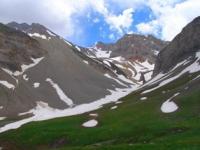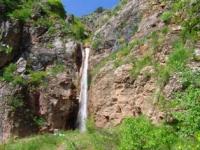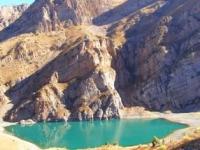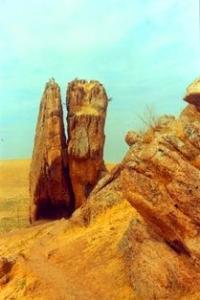Вы здесь
Sairam–Ugam Natural Park.




Travels to Sairam-Ugam Park.
“Sweetness shudders through the land
as if, freed from the heat,
nature’d scooped spring waters in her hand
and splashed her burning feet”
Fyodor Ivanovich Tyutchev. “Summer evening”.
Sights of Sairam-Ugam park.
The territory of Sairam-Ugam State National Natural Park occupies the north-eastern position in the system of Western Tien-Shan and is represented with the mountainous massifs of Ugam, Karzhantau and Boraldaitau, as well as north-western ridges of Talas Alatau.
On the territory of the park there are rivers Ugam, Sairamsu, Kaskasu, Burgulyuk, Badam, Mashat, Daubaba and Kokbulak. Tien-Shan is the northernmost from the great mountain systems of Asia. Through Zhungar Ridge and Tarbagatai it is connected with Altai and other mountains of South Siberia and Mongolia, through Pamir, Kunlun and Karakorum it is connected with Tibet and Himalayas and through Pamir and Gindukush – with Kopetdag and Iran Highlands.
All these connections make the flora and fauna of Tien-Shan richer; make it simultaneously typical for Central Asian Mountains and rather unique by the structure. This uniqueness has the global meaning because this is the place where a lot of endemic species of plants and animals are concentrated.
The territory of the park has seven natural zones from mountain-steppes to high mountains where you can see 1635 species of plants, 59 species of mammals and 300 species of birds. The plantation of the park is unique. Here are 240 species of plants, which are in the Red Book of the Republic of Kazakhstan.
It is necessary to underline that practically all Red-Book species are rare. Very rare species (Sogdina ash-tree, wild grape, Yanchevsky’s currant, Albert’s iris) have only a few specimens. On the territory of the national park open woodlands have three species of juniper: Zeravshan, semi-spherical and Turkestan.
There are also thick archa woodlands I nthe valleys of Sairamsu and Saryaigyr Rivers. Turkestan archa is the real long-liver. Very often you can find trees that are thousand year old and they are still sound and have grow normally.
At the upper border of distribution archa sometimes lives for up to 4 thousand years. Archa in the age of 500 - 600 years is quite a normal phenomenon. The most notable feature of Western Tien-Shan is the distribution of many species of wild plants, which have congeners amongst cultivated plants - apples, pears, plums, grapes, European walnut, leek and tulip.
The fauna of the park is diverse. Bears, wolves, boars, ibex, roe deer, badgers and porcupines are usual “residents” of the park. Delicate Karatau argali can be seen in the spring time on the southern slopes of Boraldai Ridge.
Very rarely you’ll see the most cautious residents of the park – snow leopard and Turkestan lynx. We should mention the distribution of the unique population of Menzbir marmot in the basin of Badam and Saryaigyr Rievrs.
Menzbir marmot is the endemic pecies of Western Tien-Shan and it can be seen only on the territory of Kazakhstan, Uzbekistan and Kyrgyzstan. Small population in Tajikistan has practically stopped existing. During last decades the number of marmots is steadily decreasing and the species is under the threat of disappearance.
Flora, fauna, landscapes, rivers, waterfalls and mountainous lakes create the picturesque unrepeatable landscapes, which have great recreation potential. On the territory of the park you can see cult facilities, rock paintings, ancient settlements and burial mounds of various historical epochs but in general the cultural landscapes of the park have been not studied well and they still wait for their researchers.
The mountains in Western Tien-Shan are the unrepeated world of wild nature. High snow tops (amongst them – Sairam Peak, 4236 meters above sea level), light blue mountainous lakes (amongst them Ugam pearl – Makpal Lake, 2100 m), pure waters of rivers and springs, Kyrykkyz rocks of amazing shapes (“40 amzingly beautiful girls), magnificent tulips etc.
Mountains are the “green heart” of the vast territory inhabited by more than a million people. Mountainous forests regulate the water flow, enrich air with oxygen and volatile production. They protect from rain floods in spring, slow down the snow melting, turn the surface flow into the underground flows and do not let mudflow and soil erosion take place.
These useful qualities of the forests have the priority significance and bring more value than the preparation of timber. Mountains provide the population of Shymkent and neighbouring areas with water resources and primarily with high-quality drinking water.
This is an invaluable gift of the nature, which many people in the steppes and deserts of Kazakhstan, as well as millions of people on the Earth, do not have. Biological diversity of the mountains is the most valuable richness, which will provide the development of future generations and it will allow preserving the genetic fund of various species.
Sairam-Ugam National Park was opened in 2006. Its area is 150 thousand hectares. The territory of the park is divided into three functional zones – reserve area, area for tourist activities and zone for recreation activities.
Activity of the national park is aimed at the achievement of basic targets – protection of natural zones of the region, arrangement of cognitive holidays for people, development of ecological tourism and propaganda amongst people of the safe treatment of nature.
Authority:
Advertising booklet of the reserve, 2006.
Photos used
with permission from Alikhan Abdeshev, Tourism Manager of Sairam-Ugam National Park.







